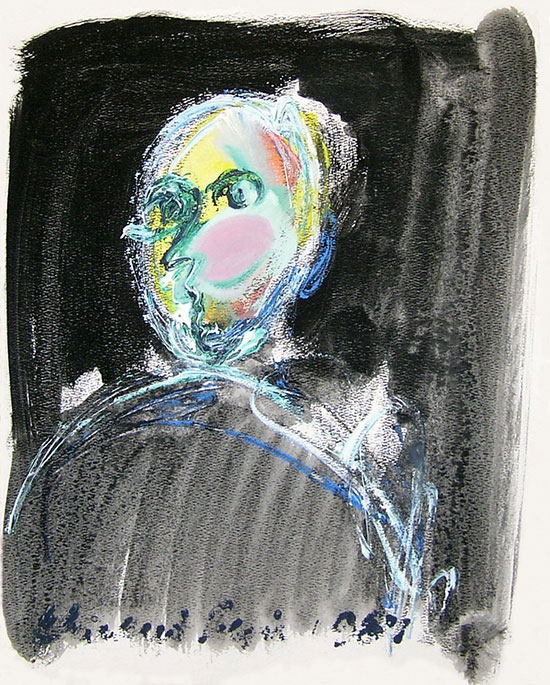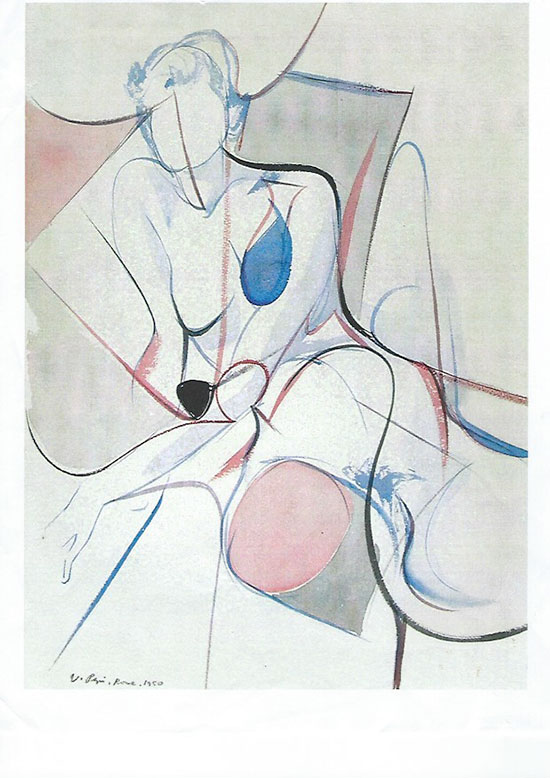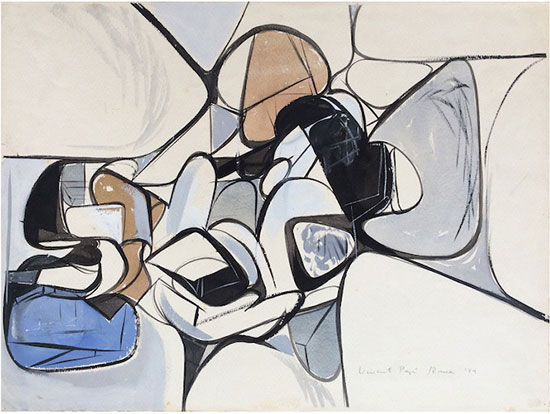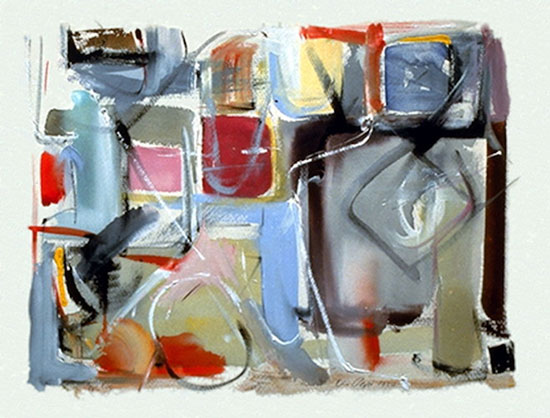I’m a sucker for synesthesia, so the swinging musical paintings on view in “Vincent Pepi: Over 50 Years of Painting” at the Quogue Gallery had me smiling from the downbeat. For just one example, the swirling medley of cool and hot tones in C-Melody, painted in 1978, backs a skittering calligraphic line as unerringly as a smooth bassist and drummer support a tenor sax.
.

"C-Melody" by Vincent Pepi, 1978. Oil on canvas, 36 x 48 inches.
.
The 90-year-old Pepi is a living link to the Olympians of New York’s Abstract Expressionist moment: he attended meetings of “the Club” with Pollock, de Kooning, Kline and the gang. His admirable stamina is celebrated in this show of highlights from a 50-year exhibition career, testimony to the enduring vitality of both the man and the movement in which he played his unique part.
The Quogue Gallery exhibition deftly connects vintage works from as far back as 1949 with later works by Pepi that bring out the ways in which he differed from many of the 10th Street artists, who prided themselves on both their American-ness and their commitment to abstraction. For one thing, unlike the predilection of many of the these artists to stay at home, travel was a vital part of Pepi’s aesthetic, as was professional illustration (which paid the studio bills).
The globetrotting artist had extended stays in Italy, Mexico and North Africa. As a composer might soak up the influence of world music, Pepi let the sights and sounds of foreign climes seep into his style, as in a vibrant series of portraits (such as 891) made in the 1980s that are reminiscent of earlier European masters of color such as Alexei Jawlensky, Kees van Dongen and the wild palette of the CoBra group, notably Karel Appel.
.

"891" by Vincent Pepi, 1987. Mixed media, 17 x 14 inches.
.
The precise itinerary of Pepi’s peregrinations is a major part of the backstory, no matter how abstract the work, because each destination left its mark. He was born in Boston and raised in Manhattan. Right out of the famed High School of Music and Art, in the days before “intern” was a euphemism for “slave,” he landed a real job as an illustrator for Good Housekeeping magazine.
He performed his military service in the U.S. Navy and then in 1946 passed the rigorous entrance examinations to secure a place at Cooper Union, supplementing the curriculum there with studio classes at Pratt. The discipline of the life drawing class pays off in the confident figural statement made by Rome Figure 2, in which the woman floats on clouds of color.
.

"Rome Figure 2" by Vincent Pepi, 1950. Giclee, 20 x 15 inches.
.
Following the well-worn path of many Ab Ex painters lured to the large scale of the murals of Siqueros and Rivera, he headed to Mexico. Back in New York, he used steady work as a graphic designer at an advertising agency as well as at New York University to fund his further wanderings and maintain a sumptuously stocked studio.
Pepi’s most fruitful study abroad was spent in Italy. In 1949, when New York was the place to be if you were part of the avant-garde, he took the bold step of skipping off to Rome for two years at the American Academy.
An even more contrarian aspect of the trip was the way that Pepi steeped his studio training in art history, especially the Old Masters. The secure bounding line and Mediterranean blue in Rome 49 (which reminded me of Robert Motherwell’s use of a similar tone) commemorate the bountiful lessons in technique that he was absorbing.
.

"Rome 49" by Vincent Pepi, 1949. Watercolor on paper, 15 x 20 inches.
.
There are traces, too, in the watercolors of 1950 on view at the Quogue show, of the Futurists as well as Matta, whose light touch with line is similar to the filaments in Pepi’s 511.
.

"511" by Vincent Pepi, 1950. Mixed media, 14.5 x 19.25 inches.
.
Pepi’s career trajectory reminds me of Conrad Marca-Relli, reviewed on Hamptons Art Hub in February, who also left New York for Italy and added a continental accent to the Ab Ex idiom. It is no surprise that Pepi and Marca-Relli, along with Franz Kline, wound up sharing the same studio building back in New York. Like Marca-Relli, Pepi found ways to marry the muscular gesture of the New York style with the palette and formal vocabulary of Italy.
A quartet of historically important works from 1949-50, a pivotal period in Pepi’s work as well as the movement’s development, offer the star turns in the show. They include 511, with its pulsing square of red like a portal to the great chromatic fantasies of Hans Hofmann. In 1951, Pepi became one of the lucky group of painters who worked under Hofmann, whose sophisticated influence is vividly on display not only in the oil paintings but in the delightful watercolors, which have Hofmann’s wind-blown spontaneity (such as the dramatic nightscape 1206).
.

"1206" by Vincent Pepi, 1992. Watercolor & gouache, 18 x 24 inches.
.
The roster of Hofmann alumni, from Lee Krasner to Fritz Bultman and so many others, continues to furnish many of the most satisfying rediscovery exhibitions from the Ab Ex period.
In the early ’50s, Pepi was flourishing as a graphic designer and carousing at the Cedar Tavern and the Club with the likes of de Kooning, Pollock and Kline. He was shown at the Stable Gallery and the March Gallery, both of them premier showcases for the movement. His place in the chronicle of the era is guaranteed by his inclusion in the collections of the Heckscher, Smithsonian, San Francisco Museum of Modern Art and NYU’s Grey Art Gallery, and he receives his due mention in Marika Herskovic’s reliable The New York School Abstract Expressionists: Artists Choice by Artists.
One of the heartening aspects of this terrific show at the light-filled Quogue Gallery is the way the later works burst with all the vigor of the early paintings, as though 50 years were nothing to a well-trained and excited hand. For example, 1397 is a mixed media rhapsody in jaunty reds, greens and blues with a hyperactive group of black gestures as irrepressibly dynamic as anything from the ’50s. But it was painted in 1996.
Like a veteran jazzman (the pianist Oscar Peterson comes to mind), Pepi rang the changes on the Ab Ex songbook with enough insight and skill to keep it fresh and command our attention today. Peterson might have just as easily been talking about Pepi when he said of himself, summarizing the secret of his endurance: “If you have something to say of any worth, then people will listen to you.”
____________________________
BASIC FACTS: “Vincent Pepi: “Over 50 Years of Painting” is on view June 16 to July 14, 2016 at the Quogue Gallery, 44 Quogue Street, Quogue, NY 11959. www.Quoguegallery.com
____________________________
Copyright 2016 Hamptons Art Hub LLC. All rights reserved.
